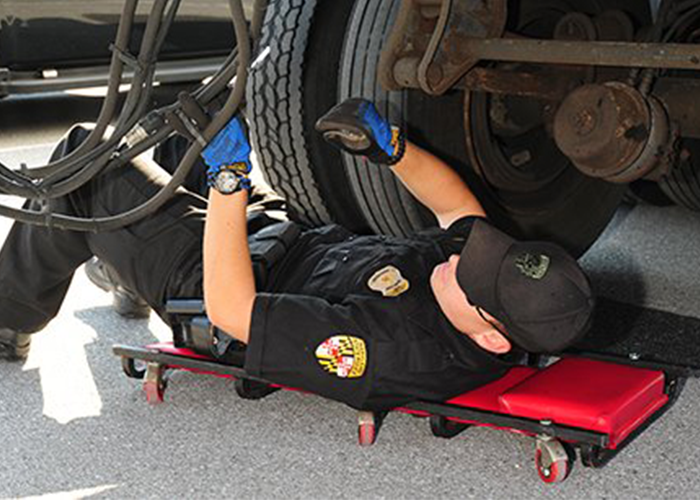The Driver’s Daily Inspection is part of a driver’s daily responsibility to protect themselves, the motoring public, and the equipment they operate. But does your driver know the difference between a “defect” and a “safety-sensitive” defect?
Drivers and technicians should understand the Federal Motor Carrier Safety Regulations contained in CFR 399 Appendix G, which defines “safety-sensitive” defects that would render the unit out of service during a pre or post-trip inspection.
Here is the Guidance for FMCSA CFR 396.11:
Question 6: Does §396.11(c) require a motor carrier to effect repairs of all items listed on a DVIR prepared by a driver before the vehicle is subsequently driven?
Guidance: The motor carrier must affect repairs of defective or missing parts and accessories listed in Appendix G to the FMCSRs before allowing the vehicle to be driven.
The Driver’s Daily Inspection Processes are a requirement of the Federal Motor Carrier Safety Regulations to ensure the vehicle is in safe operating condition.
A crucial part of each driver’s daily operation is to inspect the commercial vehicle they are operating. Two inspections of the commercial vehicle are required daily. Over the years, there has been confusion regarding pre and post-trip inspections. Let’s start with the pre-trip inspection. FMCSA regulations CFR 396.13 state that before driving a motor vehicle, the driver shall:
- Be satisfied that the vehicle is in safe operating condition.
- Review the last driver vehicle inspection report; and
- Sign the report only if the driver who prepared it acknowledges that the driver has reviewed it and that there is a certification that the required repairs have been performed and noted defects or deficiencies. The signature requirement does not apply to listed defects on a towed unit, which is no longer part of the vehicle combination.
Does the pre-trip inspection need to be documented? Although the pre-trip is not required by regulation to be documented, it is a good idea to document the inspection; I recommend that the pre-trip inspection be “flagged” on the driver’s record of duty status in the “Grid” section.
Now let’s look at the post-trip inspection. The FMCSA CFR 396.11 requires that every driver complete a post-trip inspection at the end of their tour of duty. As of December 18th, 2014, the post-trip is only required to be documented if there are defects or safety concerns. The inspection shall cover the following parts and accessories:
- Service brakes, including trailer brake connections.
- Parking (hand) brake
- Steering Mechanism
- Lighting devices and reflectors
- Tires
- Horn
- Windshield Wipers
- Rear vision mirrors
- Coupling devices
- Wheels and rims
- Emergency equipment
The report shall identify the vehicle and list any defect or deficiency that would affect the vehicle's safe operation or cause a mechanical breakdown. If there are no defects or deficiencies, a written daily vehicle inspection report in writing is not required. As the motor carrier, you have the authority to go above and beyond the regulations and require your drivers to document the post-trip inspection daily, with or without defects.
Now, suppose there are safety-sensitive defects or deficiencies noted by the driver. In that case, the motor carrier must correct or cause to have corrected the defects or deficiencies of the CMV before allowing or permitting the vehicle's operation.
Does this mean all defects and deficiencies must be corrected?
No, only those safety-sensitive defects, as outlined in appendix G of the FMCSR, would directly affect the safe operation of the CMV. Technicians, drivers, and service managers should all become familiar with appendix G to determine which defects/deficiencies must be corrected immediately and which can be held off until the next PM or later. Once the defect /deficiency(s) have been corrected the original DVIR must be “certified” as corrected or that the correction was unnecessary. The DVIR is then to be signed by the repairing technician. The “certification” is required to be on all copies of the DVIR. The driver must retain the previous days' DVIR on the CMV, and the motor carrier must maintain all DVIRs for ninety days.
If you have not reviewed appendix G of FMCSA CFR 399 with your drivers, I recommend including this information in your next driver safety meeting.
Here is the link to Appendix G:
Pre-employment Investigations for Drug and Alcohol Program Violations
As of January 6, 2023, a pre-employment Clearinghouse query satisfies the requirement to investigate a prospective driver's previous drug and alcohol program violations, as outlined in 49 CFR 391.23(e)(4) and 382.413(b).
CDL drivers' employers must conduct background investigations before hiring a driver. This process includes determining if the driver has violated the drug and alcohol regulations of any Department of Transportation (DOT) mode within the past three years (see 49 CFR 391.23(e)(1)-(3) and 382.413(a)).
As of today, January 6, 2023, three years of violation data is now stored in the Drug and Alcohol Clearinghouse. This means that prospective employers must conduct a pre-employment query of the Clearinghouse, as outlined in § 382.701(a), to comply with the inquiry requirement in §§ 382.413(b) and 391.23(e)(4), as it pertains to FMCSA-regulated employers. Inquiries not conducted under § 382.701(a) will not satisfy these inquiry requirements.
NOTE: The Clearinghouse contains only information about drivers employed by FMCSA-regulated employers. Suppose a prospective employee was employed by an employer regulated by a DOT agency other than FMCSA (such as the Federal Railroad Administration, Federal Transit Administration, Federal Aviation Administration, etc.) during the three-year period. In that case, prospective employers will still be required to directly request drug and alcohol violation information from those DOT-regulated employers in accordance with 391.23(e)(4)(ii) and 382.413(c), since this information is not reported to the Clearinghouse.
Annual query requirements have not changed. Employers of CDL drivers must conduct a query in the Clearinghouse at least once a year for each CDL driver they employ (see § 382.701(b)). This annual query requirement applies on a rolling 12-month basis, which means that if you conducted your last annual queries in December 2021, it is time to conduct the next round of annual queries.
Employers must obtain general consent from CDL drivers they employ before conducting limited queries in the Clearinghouse to view these drivers’ information (you can download a sample limited query consent form).
Are you up-to-date on your annual queries? Log in to the Clearinghouse and visit your Query History page to see if your annual queries are due. Download the How to Conduct a Limited Query job aid for instructions on conducting annual queries.
Questions?
To learn more about queries and consent requests, browse the Clearinghouse FAQs or download the Queries and Consent Requests Factsheet. This is also available in the Clearinghouse Learning Center.
If these materials do not cover your question, you can also contact the Clearinghouse Team.









